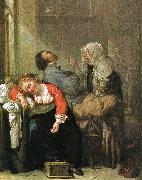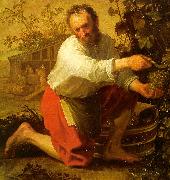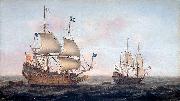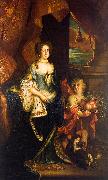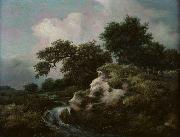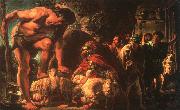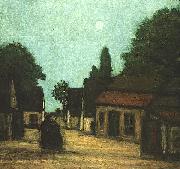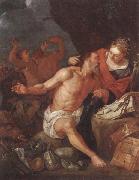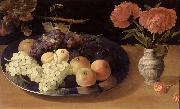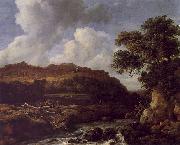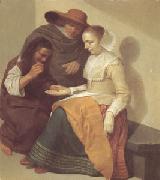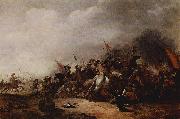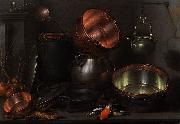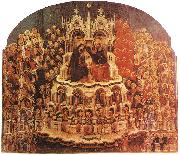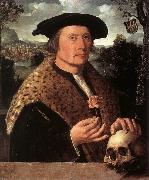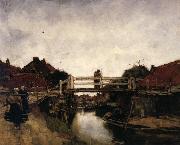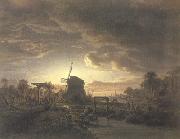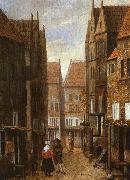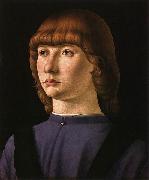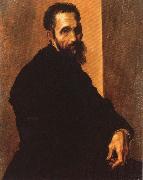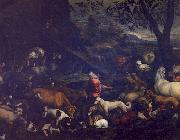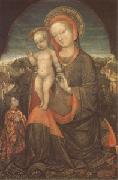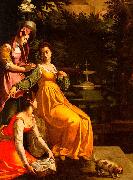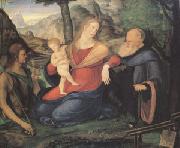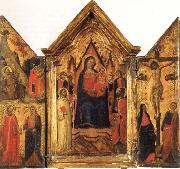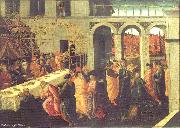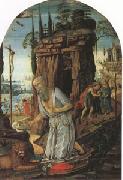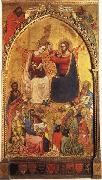|
|
 |
Jacob de Wit
|
|
(19 December 1695 - 12 November 1754) was a Dutch artist and interior decorator who painted many religious scenes.
De Wit was born in Amsterdam, and became famous for his door and ceiling paintings. He lived on the Keizersgracht in Amsterdam, and many of the buildings on the Keizersgracht still have door or ceiling paintings done by him. Since many of the families who lived in Amsterdam in those days had country villas, de Wit also painted in houses in the fashionable areas of Haarlem and the Vecht river.
According to the RKD he was the pupil of Albert Spiers in Amsterdam and Jacob van Hal in Antwerp where he became a member of the Guild of St. Luke in 1714. His pupils were Jan de Groot (painter from The Hague), Dionys van Nijmegen, Jan Punt, Pieter Tanje, and the brothers Frans and Jacob Xavery. De Wit died in Amsterdam in 1754.Tako Hajo Jelgersma was his follower. |
|
|
|
 |
Jacob Ferdinand Voet
|
|
(c. 1639 - c. 1689/1700) was a Flemish Baroque portrait painter.
According to the Netherlands Institute for Art History (RKD) he was born at Antwerp as the son of the painter Elias Voet.[1] He travelled to Rome in 1679-1680, Milan in 1680, Florence in 1681, Turin in 1682-1684, and returned to Antwerp in 1684. While in Rome he lived with the painter-engraver Cornelis Bloemaert until he was banned for his portraits of women portrayed with unseemly decollet, whereupon they left Rome together. He undertook a journey to Paris in 1686 where he became court painter until he died there.He is registered as a painter of miniature portraits.
According to Houbraken, he made his return journey to Antwerp from Turin in the company of Jan van Bunnik, who he had already met in Rome in the company of Cornelis Bloemaert. From Turin they set out for Lyons, where they met Adriaen van der Cabel, Peter van Bloemen, and Gillis Wenix. They set off for Paris in the company of a third painter who was a good painter of "bataljes" or battle scenes. Houbraken reports that this was Jacob, Jan van Bunnik's brother, but had not mentioned him earlier in his Jan van Bunnik biography. The RKD makes no mention of a Jacob van Bunnik. |
|
|
|
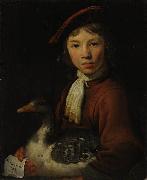 |
Jacob Gerritsz. Cuyp
|
|
was a portrait and landscape painter. He was born and died in Dordrecht, and was the half-brother of Benjamin Gerritsz Cuyp and the father of the much more famous Aelbert Cuyp.
According to Houbraken, he helped the painters Jacques de Claeuw, Isaac van Hasselt, and Cornelis Tegelberg set up a Guild of Saint Luke in Dordrecht in 1642.
|
|
|
|
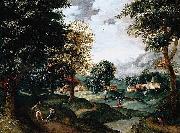 |
Jacob Grimmer
|
|
(ca. 1526-1590) was a Flemish Renaissance landscape painter.
Grimmer was born and died in Antwerp. According to Karel van Mander he first learned to paint landscapes from Matthys Cock and later from Christiaen Queburgh, both of Antwerp. He was a very skilled painter of houses, sky, and foreground views. He was a member of the Guild of St. Luke who was active as a rederijker and acted in many plays.
According to the RKD his earliest dated work is from 1546 and his latest dated work was 1589. Most of his works are landscapes and he worked together with Gillis Mostaert. Abel Grimmer was his son and pupil.
|
|
|
|
|
|
|
|
|
|
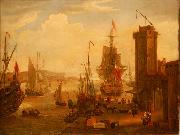 |
Jacob Knyff
|
|
(January 1, 1639, Haarlem - 1681, London), was a Dutch Golden Age painter.
According to Houbraken he was the teacher of Johannes Gottlieb Glauber in Paris in 1671, where he attended the funeral of Nicolaes Berchem II on January 4, 1672. he was probably the son of the painter Wouter Knijff, and is known for painting landscapes and seascapes |
|
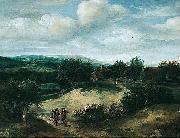 |
Jacob Koninck
|
|
(c. 1615, Amsterdam - c. 1695, Copenhagen), was a Dutch Golden Age landscape painter.
According to Houbraken he lent his books on perspective to Johannes Verkolje, who became better than he was at perspective drawing.He was a disciple of Adriaen van de Velde who became a popular painter in Copenhagen where he painted for the court of Christian V of Denmark.
According to the RKD he was the uncle of Salomon Koninck, a pupil of David Colijns and became the teacher of his son Jacob II and his younger brother Philips Koninck.He was in Dordrecht from 1633-1636, Rotterdam from 1637-1645, The Hague from 1647-1651, back in Amsterdam in 1658 (when he probably lent young Verkolje his perspective books), and moved to Denmark in 1676.
|
|
 |
Jacob Levecq
|
|
(1634 - 1675), was a Dutch Golden Age painter trained by Rembrandt.
According to Houbraken, who was his pupil during the last 9 months of his life, he had been trained by Rembrandt, but inherited a sum of money when his parents died, that he used to take care of himself, his two unmarried sisters and a blind half-brother. Houbraken could not recall much of his painting style, since he had been mostly sick while he was living in the house, and he no longer painted actively. In his younger years Levecq travelled to Paris and Sedan where he painted portraits, and on his return to Dordrecht became a portrait painter in the manner of Jan de Baen. When he died, Houbraken inherited a third of his prints, but regretted the fact that as a young boy with little experience in such matters, he only chose prints by Lucas van Leyden and Albert Durer, and had left the French prints for others, and so was very glad that he had received one anyway by Charles le Brun. |
|
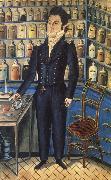 |
Jacob Maentel
|
|
American physician and watercolor portraits painter,1763-1863 |
|
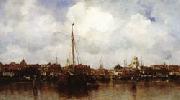 |
Jacob Maris
|
|
(August 25, 1837, The Hague - August 7, 1899, Karlsbad) was a Dutch painter, who with his brothers Willem and Matthijs belonged to what has come to be known as the Hague School of painters.
Maris studied at the Antwerp Academy, and subsequently in Hubertus van Hove's studio during a stay in Paris from 1865 till 1871. He returned to Holland when the Franco-Prussian War broke out, and died there in August 1899. Though he painted, especially in early life, domestic scenes and interiors invested with deeply sympathetic feeling, it is as a landscape painter that Maris excelled. He was the painter of bridges and windmills, of old quays, massive towers, and level banks; even more was he the painter of water, and misty skies, and chasing clouds. In all his works, whether in water or oil color, and in his etchings, the subject is always subordinate to the effect. His art is suggestive rather than decorative, and his force does not seem to depend on any preconceived method, such as a synthetical treatment of form or gradations of tone. And yet, though his means appear so simple, the artist's mind seems to communicate with the spectator's by directness of pictorial instinct, and we have only to observe the admirable balance of composition and truthful perspective to understand the sure knowledge of his business that underlies such purely impressionist handling.
|
|
|
|
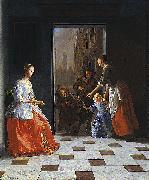 |
Jacob Ochtervelt
|
|
(1634, Rotterdam - 1682, Amsterdam), was a Dutch Golden Age painter.
According to the RKD he was active in Haarlem where he was a student of Nicolaes Pietersz Berchem and later he moved back to Rotterdam (1655-1672) where he was a pupil of Ludolf de Jongh. After the rampjaar he moved to Amsterdam |
|
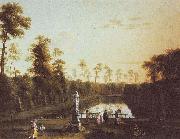 |
Jacob Philipp Hackert
|
|
(September 15, 1737 - April 28, 1807) was a landscape painter from Brandenburg, who did most of his work in Italy.
Hackert was born in 1737 in Prenzlau in the Margraviate of Brandenburg (now in Germany). He trained with his father Philipp (a portraitist and painter of animals) and his uncle, before going to the Akademie der Kenste in Berlin in 1758. Later he traveled to Swedish Pomerania and Stockholm, where he painted murals.
He spent from 1765 to 1768 in Paris, with the Swiss Artist, Balthasar Anton Dunker, where he focused on painting in gouache. He met and was inspired by Claude Joseph Vernet, who was already famous as a painter of landscapes and seascapes, and the German engraver Johann Georg Wille.
In 1768 Hackert left Paris with his brother Georg, and went to Italy, basing himself mainly in Rome and Naples, where he produced many works for Sir William Hamilton. He travelled all over Italy, gaining a reputation as a talented landscape painter.
In 1786 he went to work for Ferdinand I of the Two Sicilies in Naples. He advised on the creation of a painting restoration laboratory at the Museo di Capodimonte, and supervised the transfer of the Farnese collections from Rome to Naples. By this time he had an international reputation, and won commissions from empress Catherine II of Russia, king Louis XVI of France and others. When Goethe visited Naples in 1786, he and Hackert became friends. |
|
|
|
|
|
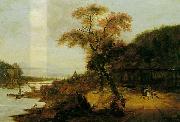 |
Jacob van der Does
|
|
(4 March 1623, Amsterdam - buried 17 November 1673, Sloten) was a Dutch Golden Age landscape painter.
Van der Does was the son of the secretary of the Amsterdam city council. He was more attracted to the arts than to note-taking, and went to study drawing with Claes Corneliszoon Moeyaert. He left at 21 to go to France, and from there on foot to Italy. In Rome he joined the Bentvueghels and was dubbed Tamboer, which means drummerboy, since he was somewhat short and had been meant for the military life. He studied with Pieter van Laer (Bamboots). When he eventually returned North, he settled in The Hague where he married Margaretha Boortens and got 4 sons and a daughter. His wife died in 1661. Houbraken liked his natural style of painting, and especially his way of painting sheep was very admirable.His wife's sister was Maria Boortens, and they both were good artists themselves. All three of them made drawings for the album of the wealthy Hague diplomat Cornelis de Glarges in 1659. Through Maria Boortens, Jacob van der Does was connected to Jacob van Campen and Adriaen van Nieulandt the younger. He became involved in the Guild of St. Luke in The Hague. He was one of the founders of the Confrerie Pictura in 1656. His pupils were Theodor Bernoille, Marcus de Bye, Gamaliel Day, Alexander Havelaer, Anthony Schinckels, and his sons Jacob II and Simon van der Does. |
|
|
|
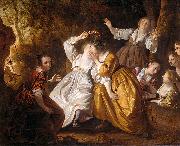 |
Jacob van Loo
|
|
(1614 - 26 November 1670) was a Flemish painter who is considered one of the Dutch Masters of the 17th Century. Van Loo is known for his conversational groupings, his use of a subtle color palette and his nudes. He was the founder of the Van Loo family of painters.
Van Loo was born in Sluis, Zeeland, in the Dutch Republic. Some sources have spe,culated that his father, Jan van Loo, may have been a notary, but more often his father is described as a painter from whom Jacob van Loo received his early training. Little is known of Van Loo's early history due to the destruction of the city archives in Sluis during World War II.
His early influences included Thomas de Keyser and Jacob Adriaensz Backer. In 1642, van Loo moved to Amsterdam, where his contemporaries included Rembrandt, Frans Hals, and Bartholomeus van der Helst. In 1643 he married the sister of the painter, Martinus Lengele. The couple had six children. They lived on Rozengracht in the Jordaan district of Amsterdam. Eglon van der Neer became one of his pupils. In 1660, Van Loo fled the city after fatally stabbing someone during an altercation at an inn. He was sentenced to death in absentia which forever prevented his return to Holland. Van Loo settled in Paris, where he was admitted to the Academie de peinture et de sculpture. He died in Paris in 1670.
Van Loo's work was done in the Baroque style that had originated in Rome. The Baroque style was popular throughout Europe during this period. Van Loo was a major influence on Johannes Vermeer as can be seen in Vermeer's painting, Diana and Her Companions.
Van Loo painted many portraits. Among his subjects were Johan Huydecoper van Maarssenveen; his sister, Leonara Huydecoper, who was married to Jan J. Hinlopen; Joan Ortt, who was later involved with Antoinette Bourignon; and his wife.
Jacob van Loo's son, Louis Abraham van Loo, was also a painter, as were his grandsons, Jean-Baptiste van Loo and Charles-Andra van Loo.
|
|
|
|
 |
Jacob van Schuppen
|
|
Born in Fontainebleau, France, as the son of the painter-engraver Pieter van Schuppen, he worked in the Netherlands before moving to Vienna. He was taught to paint by his father and his uncle Nicolas de Largilliere.
In 1719 he was registered in Luneville, but he moved in the same year to Vienna where he became court painter. In 1725 he was appointed director of the Academy of Fine Arts Vienna, when it was refounded by Emperor Charles VI as the k.k. Hofakademie der Maler, Bildhauer und Baukunst (Imperial and Royal Court Academy of painters, sculptors and architecture). |
|
|
|
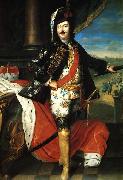 |
Jacob Wessel
|
|
painted Portrait of Hieronim Florian Radziwiłł. in 1746 |
|
|
|
|
|
|
|
|
|
|
|
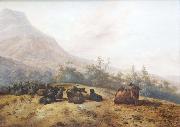 |
Jacobus Mancadan
|
|
(c. 1602, Minnertsga - 4 October 1680, Tjerkgaast) was a Dutch Golden Age painter mostly known for his pastoral landscapes.
|
|
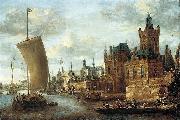 |
Jacobus Storck
|
|
(1641 - c.1700) was a Dutch Golden Age marine painter.
Storck was born and died in Amsterdam. According to Houbraken he was the brother of the marine painter Abraham Storck who painted views of the Rhine and inland ships, but who was not as gifted.
According to the RKD he was the second son of the marine painter Johannes Sturckenburgh, younger brother of the marine painter Johannes Storck and older brother of Abraham. Signed works by him are dated 1664-1687. He sometimes signed JA Storck, which since 1963 has been interpreted as a work by both Jacobus and Abraham together.
|
|
|
|
|
|
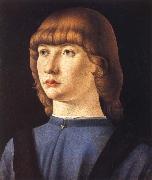 |
Jacometto
|
|
Italian Early Renaissance Painter, active 1472-1497 |
|
|
|
|
|
|
|
|
|
|
|
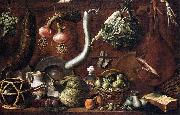 |
Jacopo Chimenti
|
|
(30 April 1551 - 30 September 1640) was an Italian late-mannerist painter.
Born in Florence as Jacopo Chimenti (Empoli being the birth place of his father), he worked mostly in his native city. He apprenticed under Maso da San Friano. Like his contemporary in Counter-Maniera (Counter-Mannerism), Santi di Tito, he moved into a style often more crisp, less contorted, and less crowded than mannerist predecessors like Vasari. He collaborated with Alessandro Tiarini in some projects. Among his pupils were Felice Ficherelli, Giovanni Battista Brazze (Il Bigio), Giovanni Battista Vanni, and Virgilio Zaballi.
In later years, the naturalism becomes less evident. The porcelain features of his figures accentuated the academic classical trends that restrained Florentine painting during the Baroque period. |
|
|
|
|
|
|
|
|
|
|
|
|
|
|








